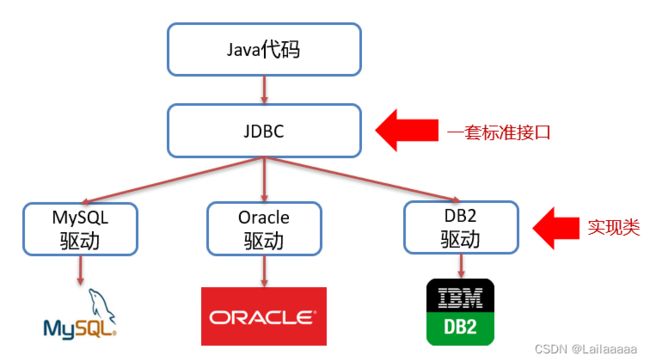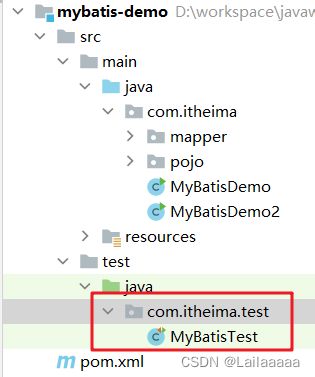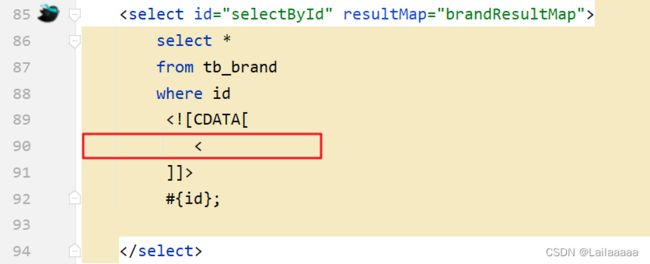JDBC和MyBatis的使用
JDBC
1.JDBC概述
JDBC 就是使用Java语言操作关系型数据库的一套API
全称:( Java DataBase Connectivity ) Java 数据库连接

我们开发的同一套Java代码是无法操作不同的关系型数据库,因为每一个关系型数据库的底层实现细节都不一样。如果这样,问题就很大了,在公司中可以在开发阶段使用的是MySQL数据库,而上线时公司最终选用oracle数据库,我们就需要对代码进行大批量修改,这显然并不是我们想看到的。我们要做到的是同一套Java代码操作不同的关系型数据库,而此时sun公司就指定了一套标准接口(JDBC),JDBC中定义了所有操作关系型数据库的规则。众所周知接口是无法直接使用的,我们需要使用接口的实现类,而这套实现类(称之为:驱动)就由各自的数据库厂商给出。
- 各数据库厂商使用相同的接口,Java代码不需要针对不同数据库分别开发
- 可随时替换底层数据库,访问数据库的Java代码基本不变
以后编写操作数据库的代码只需要面向JDBC(接口),操作哪儿个关系型数据库就需要导入该数据库的驱动包,如需要操作MySQL数据库,就需要再项目中导入MySQL数据库的驱动包。如下图就是MySQL驱动包
2.JDBC的代码步骤
-
创建工程,导入驱动jar包
-
注册驱动
Class.forName("com.mysql.jdbc.Driver"); -
获取连接
Connection conn = DriverManager.getConnection(url, username, password);Java代码需要发送SQL给MySQL服务端,就需要先建立连接
-
定义SQL语句
String sql = “update…” ; -
获取执行SQL对象
执行SQL语句需要SQL执行对象,而这个执行对象就是Statement对象
Statement stmt = conn.createStatement(); -
执行SQL
stmt.executeUpdate(sql); -
处理返回结果
-
释放资源
完整代码演示:
/**
* JDBC快速入门
*/
public class JDBCDemo {
public static void main(String[] args) throws Exception {
//1. 注册驱动
//Class.forName("com.mysql.jdbc.Driver");
//2. 获取连接
String url = "jdbc:mysql://127.0.0.1:3306/db1";
String username = "root";
String password = "1234";
Connection conn = DriverManager.getConnection(url, username, password);
//3. 定义sql
String sql = "update account set money = 2000 where id = 1";
//4. 获取执行sql的对象 Statement
Statement stmt = conn.createStatement();
//5. 执行sql
int count = stmt.executeUpdate(sql);//受影响的行数
//6. 处理结果
System.out.println(count);
//7. 释放资源
stmt.close();
conn.close();
}
}
3.API详解
3.1 DriverManager
DriverManager(驱动管理类)作用:
-
注册驱动
![[外链图片转存失败,源站可能有防盗链机制,建议将图片保存下来直接上传(img-CjBKcxwl-1671149320901)(assets/image-20210725171339346.png)]](http://img.e-com-net.com/image/info8/87bbc118727f427db387b8bdf212e8e9.jpg)
registerDriver方法是用于注册驱动的,但是我们之前做的入门案例并不是这样写的。而是如下实现
Class.forName("com.mysql.jdbc.Driver");我们查询MySQL提供的Driver类,看它是如何实现的,源码如下:
在该类中的静态代码块中已经执行了
DriverManager对象的registerDriver()方法进行驱动的注册了,那么我们只需要加载Driver类,该静态代码块就会执行。而Class.forName("com.mysql.jdbc.Driver");就可以加载Driver类。提示:
- MySQL 5之后的驱动包,可以省略注册驱动的步骤
- 自动加载jar包中META-INF/services/java.sql.Driver文件中的驱动类
-
获取数据库连接
![[外链图片转存失败,源站可能有防盗链机制,建议将图片保存下来直接上传(img-0AtKxjmP-1671149320901)(assets/image-20210725171355278.png)]](http://img.e-com-net.com/image/info8/ca7d4674825f4d5da32ed85c9ae0449f.jpg)
参数说明:
-
url : 连接路径
语法:jdbc:mysql://ip地址(域名):端口号/数据库名称?参数键值对1&参数键值对2…
示例:jdbc:mysql://127.0.0.1:3306/db1
细节:
-
如果连接的是本机mysql服务器,并且mysql服务默认端口是3306,则url可以简写为:jdbc:mysql:///数据库名称?参数键值对
-
配置 useSSL=false 参数,禁用安全连接方式,解决警告提示
-
-
user :用户名
-
poassword :密码
-
3.2 Connection
Connection(数据库连接对象)作用:
- 获取执行 SQL 的对象
- 管理事务
3.2.1 获取执行对象
-
普通执行SQL对象
Statement createStatement()入门案例中就是通过该方法获取的执行对象。
-
预编译SQL的执行SQL对象:防止SQL注入
PreparedStatement prepareStatement(sql)通过这种方式获取的
PreparedStatementSQL语句执行对象是我们一会重点要进行讲解的,它可以防止SQL注入。 -
执行存储过程的对象
CallableStatement prepareCall(sql)通过这种方式获取的
CallableStatement执行对象是用来执行存储过程的,而存储过程在MySQL中不常用,所以这个我们将不进行讲解。
3.2.2 事务管理
先回顾一下MySQL事务管理的操作:
- 开启事务 : BEGIN; 或者 START TRANSACTION;
- 提交事务 : COMMIT;
- 回滚事务 : ROLLBACK;
MySQL默认是自动提交事务
接下来学习JDBC事务管理的方法。
Connection几口中定义了3个对应的方法:
- 开启事务
![]()
参与autoCommit 表示是否自动提交事务,true表示自动提交事务,false表示手动提交事务。而开启事务需要将该参数设为为false。
- 提交事务
![]()
- 回滚事务
![]()
具体代码实现如下:
/**
* JDBC API 详解:Connection
*/
public class JDBCDemo3_Connection {
public static void main(String[] args) throws Exception {
//1. 注册驱动
//Class.forName("com.mysql.jdbc.Driver");
//2. 获取连接:如果连接的是本机mysql并且端口是默认的 3306 可以简化书写
String url = "jdbc:mysql:///db1?useSSL=false";
String username = "root";
String password = "1234";
Connection conn = DriverManager.getConnection(url, username, password);
//3. 定义sql
String sql1 = "update account set money = 3000 where id = 1";
String sql2 = "update account set money = 3000 where id = 2";
//4. 获取执行sql的对象 Statement
Statement stmt = conn.createStatement();
try {
// ============开启事务==========
conn.setAutoCommit(false);
//5. 执行sql
int count1 = stmt.executeUpdate(sql1);//受影响的行数
//6. 处理结果
System.out.println(count1);
int i = 3/0;
//5. 执行sql
int count2 = stmt.executeUpdate(sql2);//受影响的行数
//6. 处理结果
System.out.println(count2);
// ============提交事务==========
//程序运行到此处,说明没有出现任何问题,则需求提交事务
conn.commit();
} catch (Exception e) {
// ============回滚事务==========
//程序在出现异常时会执行到这个地方,此时就需要回滚事务
conn.rollback();
e.printStackTrace();
}
//7. 释放资源
stmt.close();
conn.close();
}
}
3.3 Statement
3.3.1 概述
Statement对象的作用就是用来执行SQL语句。而针对不同类型的SQL语句使用的方法也不一样。
- 执行DDL、DML语句
![]()
- 执行DQL语句
![]()
该方法涉及到了 ResultSet 对象,而这个对象我们还没有学习,一会再重点讲解。
3.3.2 代码实现
*** 执行DML语句:**
/**
* 执行DML语句
* @throws Exception
*/
@Test
public void testDML() throws Exception {
//1. 注册驱动
//Class.forName("com.mysql.jdbc.Driver");
//2. 获取连接:如果连接的是本机mysql并且端口是默认的 3306 可以简化书写
String url = "jdbc:mysql:///db1?useSSL=false";
String username = "root";
String password = "1234";
Connection conn = DriverManager.getConnection(url, username, password);
//3. 定义sql
String sql = "update account set money = 3000 where id = 1";
//4. 获取执行sql的对象 Statement
Statement stmt = conn.createStatement();
//5. 执行sql
int count = stmt.executeUpdate(sql);//执行完DML语句,受影响的行数
//6. 处理结果
//System.out.println(count);
if(count > 0){
System.out.println("修改成功~");
}else{
System.out.println("修改失败~");
}
//7. 释放资源
stmt.close();
conn.close();
}
3.4 ResultSet
3.4.1 概述
ResultSet(结果集对象)作用:
- 封装了SQL查询语句的结果。
而执行了DQL语句后就会返回该对象,对应执行DQL语句的方法如下:
ResultSet executeQuery(sql):执行DQL 语句,返回 ResultSet 对象
那么我们就需要从 ResultSet 对象中获取我们想要的数据。ResultSet 对象提供了操作查询结果数据的方法,如下:
boolean next()
- 将光标从当前位置向前移动一行
- 判断当前行是否为有效行
方法返回值说明:
- true : 有效航,当前行有数据
- false : 无效行,当前行没有数据
xxx getXxx(参数):获取数据
- xxx : 数据类型;如: int getInt(参数) ;String getString(参数)
- 参数
- int类型的参数:列的编号,从1开始
- String类型的参数: 列的名称
如下图为执行SQL语句后的结果
一开始光标指定于第一行前,如图所示红色箭头指向于表头行。当我们调用了 next() 方法后,光标就下移到第一行数据,并且方法返回true,此时就可以通过 getInt("id") 获取当前行id字段的值,也可以通过 getString("name") 获取当前行name字段的值。如果想获取下一行的数据,继续调用 next() 方法,以此类推。
3.4.2 代码实现
/**
* 执行DQL
* @throws Exception
*/
@Test
public void testResultSet() throws Exception {
//1. 注册驱动
//Class.forName("com.mysql.jdbc.Driver");
//2. 获取连接:如果连接的是本机mysql并且端口是默认的 3306 可以简化书写
String url = "jdbc:mysql:///db1?useSSL=false";
String username = "root";
String password = "1234";
Connection conn = DriverManager.getConnection(url, username, password);
//3. 定义sql
String sql = "select * from account";
//4. 获取statement对象
Statement stmt = conn.createStatement();
//5. 执行sql
ResultSet rs = stmt.executeQuery(sql);
//6. 处理结果, 遍历rs中的所有数据
/* // 6.1 光标向下移动一行,并且判断当前行是否有数据
while (rs.next()){
//6.2 获取数据 getXxx()
int id = rs.getInt(1);
String name = rs.getString(2);
double money = rs.getDouble(3);
System.out.println(id);
System.out.println(name);
System.out.println(money);
System.out.println("--------------");
}*/
// 6.1 光标向下移动一行,并且判断当前行是否有数据
while (rs.next()){
//6.2 获取数据 getXxx()
int id = rs.getInt("id");
String name = rs.getString("name");
double money = rs.getDouble("money");
System.out.println(id);
System.out.println(name);
System.out.println(money);
System.out.println("--------------");
}
//7. 释放资源
rs.close();
stmt.close();
conn.close();
}
MyBatis
1.1 Mybatis概述
1.1.1 Mybatis概念
MyBatis 是一款优秀的持久层框架,用于简化 JDBC 开发
MyBatis 本是 Apache 的一个开源项目iBatis, 2010年这个项目由apache software foundation 迁移到了google code,并且改名为MyBatis 。2013年11月迁移到Github
官网:https://mybatis.org/mybatis-3/zh/index.html
持久层:
-
负责将数据到保存到数据库的那一层代码。
以后开发我们会将操作数据库的Java代码作为持久层。而Mybatis就是对jdbc代码进行了封装。
-
JavaEE三层架构:表现层、业务层、持久层
三层架构在后期会给大家进行讲解,今天先简单的了解下即可。
框架:
- 框架就是一个半成品软件,是一套可重用的、通用的、软件基础代码模型
- 在框架的基础之上构建软件编写更加高效、规范、通用、可扩展
1.1.2 JDBC 缺点
下面是 JDBC 代码,我们通过该代码分析都存在什么缺点:
-
硬编码
-
注册驱动、获取连接
上图标1的代码有很多字符串,而这些是连接数据库的四个基本信息,以后如果要将Mysql数据库换成其他的关系型数据库的话,这四个地方都需要修改,如果放在此处就意味着要修改我们的源代码。
-
SQL语句
上图标2的代码。如果表结构发生变化,SQL语句就要进行更改。这也不方便后期的维护。
-
-
操作繁琐
-
手动设置参数
-
手动封装结果集
上图标4的代码是对查询到的数据进行封装,而这部分代码是没有什么技术含量,而且特别耗费时间的。
-
1.1.3 Mybatis 优化
- 硬编码可以配置到配置文件
- 操作繁琐的地方mybatis都自动完成
如图所示
2 Mybatis的使用
1.1 环境准备
数据库表(tb_brand)及数据准备
-- 删除tb_brand表
drop table if exists tb_brand;
-- 创建tb_brand表
create table tb_brand
(
-- id 主键
id int primary key auto_increment,
-- 品牌名称
brand_name varchar(20),
-- 企业名称
company_name varchar(20),
-- 排序字段
ordered int,
-- 描述信息
description varchar(100),
-- 状态:0:禁用 1:启用
status int
);
-- 添加数据
insert into tb_brand (brand_name, company_name, ordered, description, status)
values ('三只松鼠', '三只松鼠股份有限公司', 5, '好吃不上火', 0),
('华为', '华为技术有限公司', 100, '华为致力于把数字世界带入每个人、每个家庭、每个组织,构建万物互联的智能世界', 1),
('小米', '小米科技有限公司', 50, 'are you ok', 1);
实体类 Brand
在 com.itheima.pojo 包下创建 Brand 实体类。
public class Brand {
// id 主键
private Integer id;
// 品牌名称
private String brandName;
// 企业名称
private String companyName;
// 排序字段
private Integer ordered;
// 描述信息
private String description;
// 状态:0:禁用 1:启用
private Integer status;
//省略 setter and getter。自己写时要补全这部分代码
}
-
编写测试用例
测试代码需要在
test/java目录下创建包及测试用例。项目结构如下:
-
安装 MyBatisX 插件
1.2 查询所有数据
如上图所示就页面上展示的数据,而这些数据需要从数据库进行查询。接下来我们就来讲查询所有数据功能,而实现该功能我们分以下步骤进行实现:
-
编写接口方法:Mapper接口
-
参数:无
查询所有数据功能是不需要根据任何条件进行查询的,所以此方法不需要参数。
-
结果:List
我们会将查询出来的每一条数据封装成一个
Brand对象,而多条数据封装多个Brand对象,需要将这些对象封装到List集合中返回。
- 执行方法、测试
1.3代码演示:
-
#### 编写接口方法
在 `com.itheima.mapper` 包写创建名为 `BrandMapper` 的接口。并在该接口中定义 `List<Brand> selectAll()` 方法。
public interface BrandMapper {
/**
* 查询所有
*/
List<Brand> selectAll();
}
#### 编写SQL语句
在 `reources` 下创建 `com/itheima/mapper` 目录结构,并在该目录下创建名为 `BrandMapper.xml` 的映射配置文件
<?xml version="1.0" encoding="UTF-8" ?>
<!DOCTYPE mapper
PUBLIC "-//mybatis.org//DTD Mapper 3.0//EN"
"http://mybatis.org/dtd/mybatis-3-mapper.dtd">
<mapper namespace="com.itheima.mapper.BrandMapper">
<select id="selectAll" resultType="brand">
select *
from tb_brand;
</select>
</mapper>
#### 编写测试方法
在 `MybatisTest` 类中编写测试查询所有的方法
@Test
public void testSelectAll() throws IOException {
//1. 获取SqlSessionFactory
String resource = "mybatis-config.xml";
InputStream inputStream = Resources.getResourceAsStream(resource);
SqlSessionFactory sqlSessionFactory = new SqlSessionFactoryBuilder().build(inputStream);
//2. 获取SqlSession对象
SqlSession sqlSession = sqlSessionFactory.openSession();
//3. 获取Mapper接口的代理对象
BrandMapper brandMapper = sqlSession.getMapper(BrandMapper.class);
//4. 执行方法
List<Brand> brands = brandMapper.selectAll();
System.out.println(brands);
//5. 释放资源
sqlSession.close();
}
从上面结果我们看到了问题,有些数据封装成功了,而有些数据并没有封装成功。为什么这样呢?
这个问题可以通过两种方式进行解决:
- 给字段起别名
- 使用resultMap定义字段和属性的映射关系
1.4起别名解决上述问题
从上面结果可以看到 brandName 和 companyName 这两个属性的数据没有封装成功,查询 实体类 和 表中的字段 发现,在实体类中属性名是 brandName 和 companyName ,而表中的字段名为 brand_name 和 company_name,如下图所示 。那么我们只需要保持这两部分的名称一致这个问题就迎刃而解。

我们可以在写sql语句时给这两个字段起别名,将别名定义成和属性名一致即可。
<select id="selectAll" resultType="brand">
select
id, brand_name as brandName, company_name as companyName, ordered, description, status
from tb_brand;
select>
而上面的SQL语句中的字段列表书写麻烦,如果表中还有更多的字段,同时其他的功能也需要查询这些字段时就显得我们的代码不够精炼。Mybatis提供了sql 片段可以提高sql的复用性。
SQL片段:
-
将需要复用的SQL片段抽取到
sql标签中<sql id="brand_column"> id, brand_name as brandName, company_name as companyName, ordered, description, status sql>id属性值是唯一标识,引用时也是通过该值进行引用。
-
在原sql语句中进行引用
使用
include标签引用上述的 SQL 片段,而refid指定上述 SQL 片段的id值。<select id="selectAll" resultType="brand"> select <include refid="brand_column" /> from tb_brand; select>
1.5 使用resultMap解决上述问题
起别名 + sql片段的方式可以解决上述问题,但是它也存在问题。如果还有功能只需要查询部分字段,而不是查询所有字段,那么我们就需要再定义一个 SQL 片段,这就显得不是那么灵活。
那么我们也可以使用resultMap来定义字段和属性的映射关系的方式解决上述问题。
-
在映射配置文件中使用resultMap定义 字段 和 属性 的映射关系
<resultMap id="brandResultMap" type="brand"> <result column="brand_name" property="brandName"/> <result column="company_name" property="companyName"/> resultMap>注意:在上面只需要定义 字段名 和 属性名 不一样的映射,而一样的则不需要专门定义出来。
-
SQL语句正常编写
<select id="selectAll" resultMap="brandResultMap"> select * from tb_brand; select>
1.6 小结
实体类属性名 和 数据库表列名 不一致,不能自动封装数据
- ==起别名:==在SQL语句中,对不一样的列名起别名,别名和实体类属性名一样
- 可以定义 片段,提升复用性
- ==resultMap:==定义 完成不一致的属性名和列名的映射
而我们最终选择使用 resultMap的方式。查询映射配置文件中查询所有的 statement 书写如下:
<resultMap id="brandResultMap" type="brand">
<result column="brand_name" property="brandName"/>
<result column="company_name" property="companyName"/>
resultMap>
<select id="selectAll" resultMap="brandResultMap">
select *
from tb_brand;
select>
3 查询详情
有些数据的属性比较多,在页面表格中无法全部实现,而只会显示部分,而其他属性数据的查询可以通过 查看详情 来进行查询,如上图所示。
查看详情功能实现步骤:
-
编写接口方法:Mapper接口
-
参数:id
查看详情就是查询某一行数据,所以需要根据id进行查询。而id以后是由页面传递过来。
-
结果:Brand
根据id查询出来的数据只要一条,而将一条数据封装成一个Brand对象即可
-
-
编写SQL语句:SQL映射文件
-
执行方法、进行测试
3.1 编写接口方法
在 BrandMapper 接口中定义根据id查询数据的方法
/**
* 查看详情:根据Id查询
*/
Brand selectById(int id);
3.2 编写SQL语句
在 BrandMapper.xml 映射配置文件中编写 statement,使用 resultMap 而不是使用 resultType
<select id="selectById" resultMap="brandResultMap">
select *
from tb_brand where id = #{id};
select>
注意:上述SQL中的 #{id}先这样写,一会我们再详细讲解
3.3 编写测试方法
在 test/java 下的 com.itheima.mapper 包下的 MybatisTest类中 定义测试方法
@Test
public void testSelectById() throws IOException {
//接收参数,该id以后需要传递过来
int id = 1;
//1. 获取SqlSessionFactory
String resource = "mybatis-config.xml";
InputStream inputStream = Resources.getResourceAsStream(resource);
SqlSessionFactory sqlSessionFactory = new SqlSessionFactoryBuilder().build(inputStream);
//2. 获取SqlSession对象
SqlSession sqlSession = sqlSessionFactory.openSession();
//3. 获取Mapper接口的代理对象
BrandMapper brandMapper = sqlSession.getMapper(BrandMapper.class);
//4. 执行方法
Brand brand = brandMapper.selectById(id);
System.out.println(brand);
//5. 释放资源
sqlSession.close();
}
执行测试方法结果如下:
3.4 参数占位符
查询到的结果很好理解就是id为1的这行数据。而这里我们需要看控制台显示的SQL语句,能看到使用?进行占位。说明我们在映射配置文件中的写的 #{id} 最终会被?进行占位。接下来我们就聊聊映射配置文件中的参数占位符。
mybatis提供了两种参数占位符:
-
#{} :执行SQL时,会将 #{} 占位符替换为?,将来自动设置参数值。从上述例子可以看出使用#{} 底层使用的是
PreparedStatement -
${} :拼接SQL。底层使用的是
Statement,会存在SQL注入问题。如下图将 映射配置文件中的 #{} 替换成 ${} 来看效果<select id="selectById" resultMap="brandResultMap"> select * from tb_brand where id = ${id}; select>重新运行查看结果如下:
==注意:==从上面两个例子可以看出,以后开发我们使用 #{} 参数占位符。
3.5 parameterType使用
对于有参数的mapper接口方法,我们在映射配置文件中应该配置 ParameterType 来指定参数类型。只不过该属性都可以省略。如下图:
<select id="selectById" parameterType="int" resultMap="brandResultMap">
select *
from tb_brand where id = ${id};
select>
3.6 SQL语句中特殊字段处理
以后肯定会在SQL语句中写一下特殊字符,比如某一个字段大于某个值,如下图
可以看出报错了,因为映射配置文件是xml类型的问题,而 > < 等这些字符在xml中有特殊含义,所以此时我们需要将这些符号进行转义,可以使用以下两种方式进行转义
4其他查询:
代码演示:
<mapper namespace="com.laila.mapper.BrandMapper">
<resultMap id="brandResultMap" type="brand">
<result column="brand_name" property="brandName" />
<result column="company_name" property="companyName" />
resultMap>
<select id="selectAll" resultMap="brandResultMap">
select
*
from tb_brand;
select>
<select id="selectByCondition" resultMap="brandResultMap">
select *
from tb_brand
<where>
<if test="status != null">
and status = #{status}
if>
<if test="companyName != null and companyName != ''">
and company_name like #{companyName}
if>
<if test="brandName != null and brandName != ''">
and brand_name like #{brandName}
if>
where>
select>
<insert id="add" useGeneratedKeys="true" keyProperty="id">
insert into tb_brand(brand_name,company_name,ordered,description,status)
values (#{brandName},#{companyName},#{ordered},#{description},#{status});
insert>
<update id="updateAll">
update tb_brand
set brand_name = #{brandName},company_name = #{companyName},ordered = #{ordered},description = #{description},status = #{status}
where id = #{id};
update>
<update id="update">
update tb_brand
<set>
<if test="brandName != null and brandName != ''">
brand_name = #{brandName},
if>
<if test="companyName != null and companyName != ''">
company_name = #{companyName},
if>
<if test="ordered != null">
ordered = #{ordered},
if>
<if test="description != null and description != ''">
description = #{description},
if>
<if test="status != null and status != ''">
status = #{status}
if>
set>
where id = #{id};
update>
<delete id="deleteById">
delete
from tb_brand
where id = #{id};
delete>
<delete id="deleteByIds">
delete
from tb_brand where id
in (
<foreach collection="ids" item="id" separator=",">
#{id}
foreach>
);
delete>
public interface BrandMapper {
//查询所有
List<Brand> selectAll();
@ResultMap
("brandResultMap")@Select("select * from tb_brand where id =#{id};")
//查看详情 id
Brand selectById(int id);
/*
条件查询
☆参数接收
1.散装参数:如果方法中有多个参数,需要使用@Param ( "SQL参数占位符名称")
2.对象参数
3. map集合参数
多个参数或者数组啥的都会默认设为map集合 所以一定要用注解 这样的话 #{}括号里面的才能填参数的名称
*/
//List selectByCondition(@Param("status") int status,@Param ("companyName") String companyName,@Param("brandName")String brandName);
List<Brand> selectByCondition(Brand brand);
//List selectByCondition(Map map);
//增加数据
void add(Brand brand);
//修改全部信息
void updateAll(Brand brand);
//修改部分信息
void update(Brand brand);
//根据ID删除
void deleteById(int id);
//批量删除
void deleteByIds(@Param("ids") int[] ids);
}
测试类:
public class MybatisTest {
@Test
public void testSelectAll() throws IOException {
//1.加载mybatis的核心配置文件 获取SqlSessionFactory
String resource = "mybatis-config.xml" ;
InputStream inputStream = Resources.getResourceAsStream(resource);
SqlSessionFactory sqlSessionFactory = new SqlSessionFactoryBuilder().build(inputStream);
//2.获取SqlSession
SqlSession sqlSession = sqlSessionFactory.openSession();
//3.
BrandMapper mapper = sqlSession.getMapper(BrandMapper.class);
List<Brand> brands = mapper.selectAll();
System.out.println(brands);
sqlSession.close();
}
@Test
public void testSelectById() throws IOException {
//
int id = 1;
//1.加载mybatis的核心配置文件 获取SqlSessionFactory
String resource = "mybatis-config.xml" ;
InputStream inputStream = Resources.getResourceAsStream(resource);
SqlSessionFactory sqlSessionFactory = new SqlSessionFactoryBuilder().build(inputStream);
//2.获取SqlSession
SqlSession sqlSession = sqlSessionFactory.openSession();
//3.
BrandMapper mapper = sqlSession.getMapper(BrandMapper.class);
Brand brand = mapper.selectById(id);
System.out.println(brand);
sqlSession.close();
}
@Test
public void testSelectByCondtion() throws IOException {
//接收参数
// int status = 1;
String companyName = "华为";
// String brandName = "华为";
//处理参数
companyName ="%" + companyName + "%";
// brandName ="%" + brandName + "%";
//封装对象
Brand brand = new Brand();
// brand.setStatus(status);
brand.setCompanyName(companyName);
// brand.setBrandName(brandName);
//1.加载mybatis的核心配置文件 获取SqlSessionFactory
String resource = "mybatis-config.xml" ;
InputStream inputStream = Resources.getResourceAsStream(resource);
SqlSessionFactory sqlSessionFactory = new SqlSessionFactoryBuilder().build(inputStream);
//2.获取SqlSession
SqlSession sqlSession = sqlSessionFactory.openSession();
//3.
BrandMapper mapper = sqlSession.getMapper(BrandMapper.class);
List<Brand> brands = mapper.selectByCondition(brand);
System.out.println(brands);
sqlSession.close();
}
@Test
public void testadd() throws IOException {
//接收参数
int status = 1;
String companyName = "苹果手机";
String brandName = "手机";
String description = "手机王中王";
int ordered = 100;
//处理参数
// companyName ="%" + companyName + "%";
// brandName ="%" + brandName + "%";
//封装对象
Brand brand = new Brand();
brand.setStatus(status);
brand.setCompanyName(companyName);
brand.setBrandName(brandName);
brand.setDescription(description);
brand.setOrdered(ordered);
//1.加载mybatis的核心配置文件 获取SqlSessionFactory
String resource = "mybatis-config.xml" ;
InputStream inputStream = Resources.getResourceAsStream(resource);
SqlSessionFactory sqlSessionFactory = new SqlSessionFactoryBuilder().build(inputStream);
//2.获取SqlSession
SqlSession sqlSession = sqlSessionFactory.openSession(true);
//3.
BrandMapper mapper = sqlSession.getMapper(BrandMapper.class);
//4.执行方法
// //提交事务
// sqlSession.commit();
sqlSession.close();
}
@Test
public void testUpdateAll() throws IOException {
//接收参数
int id =5;
int status = 1;
String companyName = "中华人民共和国国籍有限公司";
String brandName = "RNG";
String description = "我支持RNG,我有日本国籍";
int ordered = 1000;
//处理参数
// companyName ="%" + companyName + "%";
// brandName ="%" + brandName + "%";
//封装对象
Brand brand = new Brand();
brand.setStatus(status);
brand.setCompanyName(companyName);
brand.setBrandName(brandName);
brand.setDescription(description);
brand.setOrdered(ordered);
brand.setId(id);
//1.加载mybatis的核心配置文件 获取SqlSessionFactory
String resource = "mybatis-config.xml" ;
InputStream inputStream = Resources.getResourceAsStream(resource);
SqlSessionFactory sqlSessionFactory = new SqlSessionFactoryBuilder().build(inputStream);
//2.获取SqlSession
SqlSession sqlSession = sqlSessionFactory.openSession(true);
//3.
BrandMapper mapper = sqlSession.getMapper(BrandMapper.class);
//4.执行方法
mapper.update(brand);
// //提交事务
// sqlSession.commit();
sqlSession.close();
}
@Test
public void testUpdate() throws IOException {
//接收参数
int id =7;
int status = 1;
String companyName = "爱疯技术有限公司";
String brandName = "iPhone";
// String description = "";
// int ordered = 1000;
//处理参数
// companyName ="%" + companyName + "%";
// brandName ="%" + brandName + "%";
//封装对象
Brand brand = new Brand();
brand.setStatus(status);
brand.setCompanyName(companyName);
brand.setBrandName(brandName);
// brand.setDescription(description);
// brand.setOrdered(ordered);
brand.setId(id);
//1.加载mybatis的核心配置文件 获取SqlSessionFactory
String resource = "mybatis-config.xml" ;
InputStream inputStream = Resources.getResourceAsStream(resource);
SqlSessionFactory sqlSessionFactory = new SqlSessionFactoryBuilder().build(inputStream);
//2.获取SqlSession
SqlSession sqlSession = sqlSessionFactory.openSession(true);
//3.
BrandMapper mapper = sqlSession.getMapper(BrandMapper.class);
//4.执行方法
mapper.update(brand);
// //提交事务
// sqlSession.commit();
sqlSession.close();
}
//删除
@Test
public void testDelete() throws IOException {
//接收参数
int id =6;
// int status = 1;
// String companyName = "爱疯技术有限公司";
// String brandName = "iPhone";
// String description = "";
// int ordered = 1000;
//处理参数
// companyName ="%" + companyName + "%";
// brandName ="%" + brandName + "%";
//封装对象
// Brand brand = new Brand();
// brand.setStatus(status);
// brand.setCompanyName(companyName);
// brand.setBrandName(brandName);
// brand.setDescription(description);
// brand.setOrdered(ordered);
// brand.setId(id);
//1.加载mybatis的核心配置文件 获取SqlSessionFactory
String resource = "mybatis-config.xml" ;
InputStream inputStream = Resources.getResourceAsStream(resource);
SqlSessionFactory sqlSessionFactory = new SqlSessionFactoryBuilder().build(inputStream);
//2.获取SqlSession
SqlSession sqlSession = sqlSessionFactory.openSession(true);
//3.
BrandMapper mapper = sqlSession.getMapper(BrandMapper.class);
//4.执行方法
mapper.deleteById(id);
// //提交事务
// sqlSession.commit();
sqlSession.close();
}
//批量删除
@Test
public void testDeleteByIds() throws IOException {
//接收参数
int[] ids = {5,7,8};
// int status = 1;
// String companyName = "爱疯技术有限公司";
// String brandName = "iPhone";
// String description = "";
// int ordered = 1000;
//处理参数
// companyName ="%" + companyName + "%";
// brandName ="%" + brandName + "%";
//封装对象
// Brand brand = new Brand();
// brand.setStatus(status);
// brand.setCompanyName(companyName);
// brand.setBrandName(brandName);
// brand.setDescription(description);
// brand.setOrdered(ordered);
// brand.setId(id);
//1.加载mybatis的核心配置文件 获取SqlSessionFactory
String resource = "mybatis-config.xml" ;
InputStream inputStream = Resources.getResourceAsStream(resource);
SqlSessionFactory sqlSessionFactory = new SqlSessionFactoryBuilder().build(inputStream);
//2.获取SqlSession
SqlSession sqlSession = sqlSessionFactory.openSession(true);
//3.
BrandMapper mapper = sqlSession.getMapper(BrandMapper.class);
//4.执行方法
mapper.deleteByIds(ids);
// //提交事务
// sqlSession.commit();
sqlSession.close();
}


















